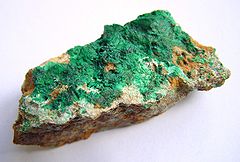- Cornubite
-
Cornubite 
Cornubite from Majuba Hill, Nevada, USA. Specimen size 5 cmGeneral Category Arsenate minerals Chemical formula Cu5(AsO4)2(OH)4 Strunz classification 08.BD.30 Dana classification 41.04.02.01 Identification Color Light or dark green Crystal habit Fibrous, botryoidal, globular or massive, also rare tabular crystals Crystal system Triclinic 1 Cleavage Distinct in two directions Mohs scale hardness 4 Luster Vitreous Streak Light green Diaphaneity Translucent[1][2] to transparent[3] Specific gravity 4.64 Optical properties Biaxial (-) Refractive index Nα = 1.87, Nβ not determined, Nγ = 1.90 Birefringence r>v Other characteristics Not radioactive References [1][2][3][4] Cornubite is a rare secondary copper arsenate mineral with formula: Cu5(AsO4)2(OH)4. It was first described for its discovery in 1958 in Wheal Carpenter, Gwinear, Cornwall, England, UK.[5] The name is from Cornubia, the medieval Latin name for Cornwall.[1] It is a dimorph of Cornwallite, and the arsenic analogue of pseudomalachite.
Contents
Physical properties
Cleavage is distinct in two directions, both perpendicular to the enlarged faces of the tabular crystals, intersecting at about 70o. Cornubite is fairly soft, with hardness 4, the same as fluorite, and specific gravity 4.64, which is similar to another copper arsenate, clinoclase, at 4.38, but much denser than quartz, at 2.66.
Optical properties
All triclinic minerals are biaxial; cornubite is biaxial (-). Its refractive indices are quite high, close to 1.9, similar to zircon and garnet. It is green, as are many copper minerals, usually translucent, with a vitreous luster and a light green streak.
Unit cell
Cornubite belongs to the triclinic crystal class 1, space group P1, meaning that it has a very low symmetry, with only a center of symmetry and no mirror planes or axes of symmetry. In 1984 Sieber, Hofmeister, Tillmans and Abraham reported new data from microprobe analysis of cornubite, which gave unit cell parameters a = 6.121 Å, b = 6.251 Å, c = 6.790 Å, α = 92.93°, β = 111.3°, γ = 107.47° and Z=1.[6]
Structure
The structure is made up of sheets of edge-shared Cu(O,OH)6 octahedra, with a copper atom Cu in the middle of the octahedron and either oxygen O or hydroxyl OH at each of the six vertices. These sheets are connected together by AsO4 groups with an arsenic As atom in the middle and O at each of the four vertices. In the AsO4 groups three of the O's are shared with octahedra in one octahedral sheet, and the fourth O is shared with an octahedron in the adjacent sheet. Hydrogen bonds also connect the sheets together.[3]
Crystal habit
Crystals, which are very rare, are tabular, often in aggregates as rosettes. Cornubite is generally fibrous, botryoidal, globular or massive.
Environment
Cornubite is a secondary mineral found in the oxidised zone of copper deposits. In Cornwall it is found in drusy quartz associated with malachite, Cu2(CO3)(OH)2, olivenite, Cu2(AsO4)(OH), cuprite, Cu2O, cornwallite, Cu2+5(AsO4)2(OH)2, and liroconite, Cu2+2Al(AsO4)(OH)4·4H2O.[3] Some of the world’s best specimens come from the Majuba Hill Mine in the Antelope District, Nevada, USA. Cornubite occurs there as light green botryoidal crusts on rhyolite or as balls and crusts on cornwallite, also as coatings on clinoclase and pseudomorphs after parnauite.[7] Other associations are with chalcophyllite, chenevixite, pseudomalachite, bayldonite, tyrolite, azurite and chrysocolla.[2]
Type locality
The type locality is Wheal Carpenter, Gwinear, Cornwall, UK. The type material is conserved at the Natural History Museum, London, reference BM.1958,122
References
- ^ a b c http://www.mindat.org/min-1132.html
- ^ a b c http://rruff.geo.arizona.edu/doclib/hom/cornubite.pdf
- ^ a b c d Gaines et al (1997) Dana’s New Mineralogy Eighth Edition, Wiley
- ^ http://www.webmineral.com/data/Cornubite.shtml
- ^ Claringbull, Hey and Davis, American Mineralogist (1959) 44: 1321
- ^ American Mineralogist (1985)70: 1333
- ^ Castor and Ferdock (2004) Minerals of Nevada, Nevada Bureau of Mines and Geology with the University of Nevada Press
External links
Jmol: http://rruff.geo.arizona.edu/AMS/viewJmol.php?id=13776
Categories:- Arsenate minerals
- Copper minerals
Wikimedia Foundation. 2010.
